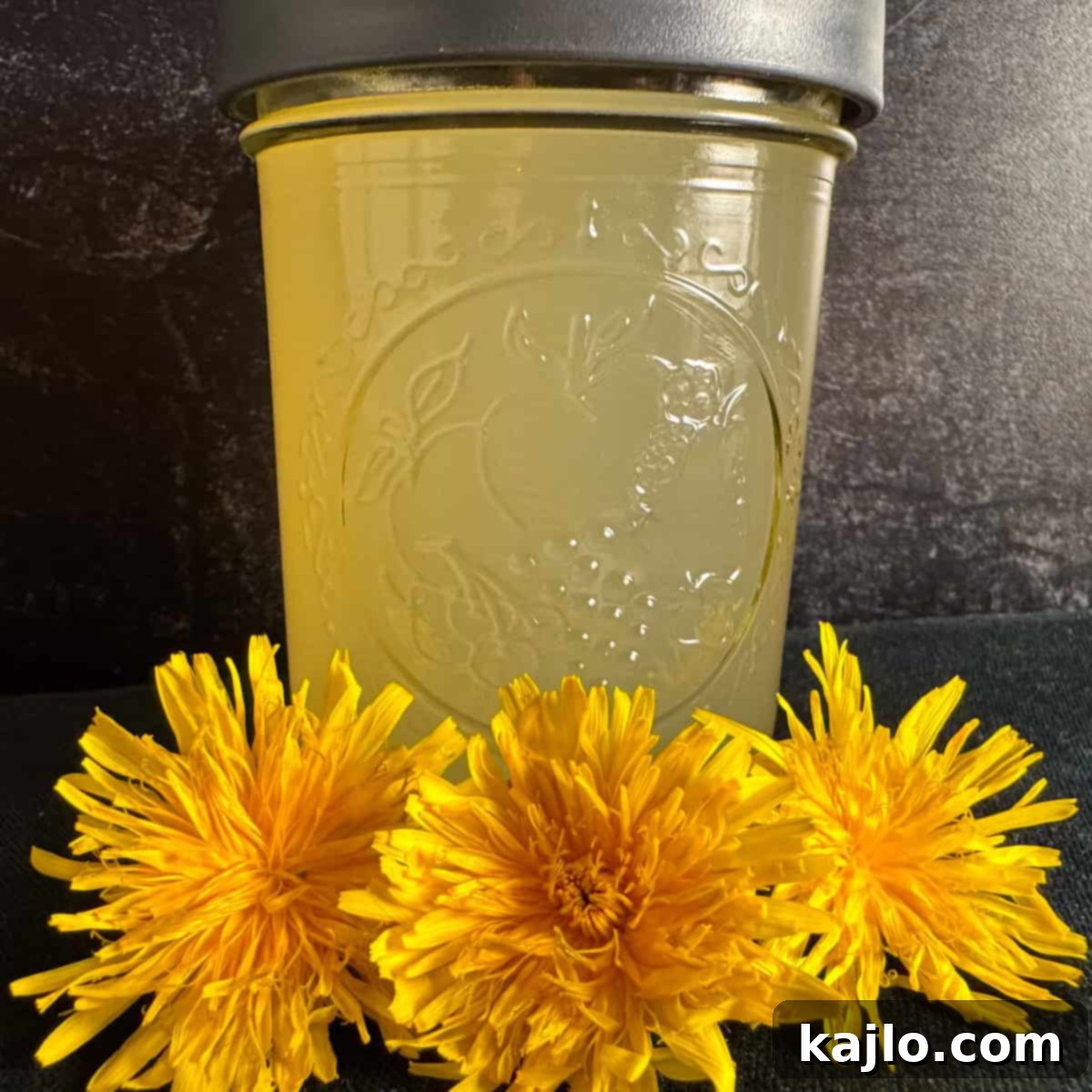While many see dandelions as mere weeds, those in the know recognize their incredible versatility and flavor, especially when transformed into delightful dandelion vinegar. If your lawn is currently dotted with these vibrant yellow blossoms, you hold the key to a surprisingly gourmet ingredient. This comprehensive guide will walk you through two distinct methods to create your own dandelion vinegar: an easy infused version and a more traditional from-scratch approach using sugar and water. Both the leaves and blossoms of this humble plant are not only edible but offer unique tastes that can elevate your culinary creations. Get ready to embrace the abundant charm of dandelions as we turn these sunny flowers into a pantry staple!
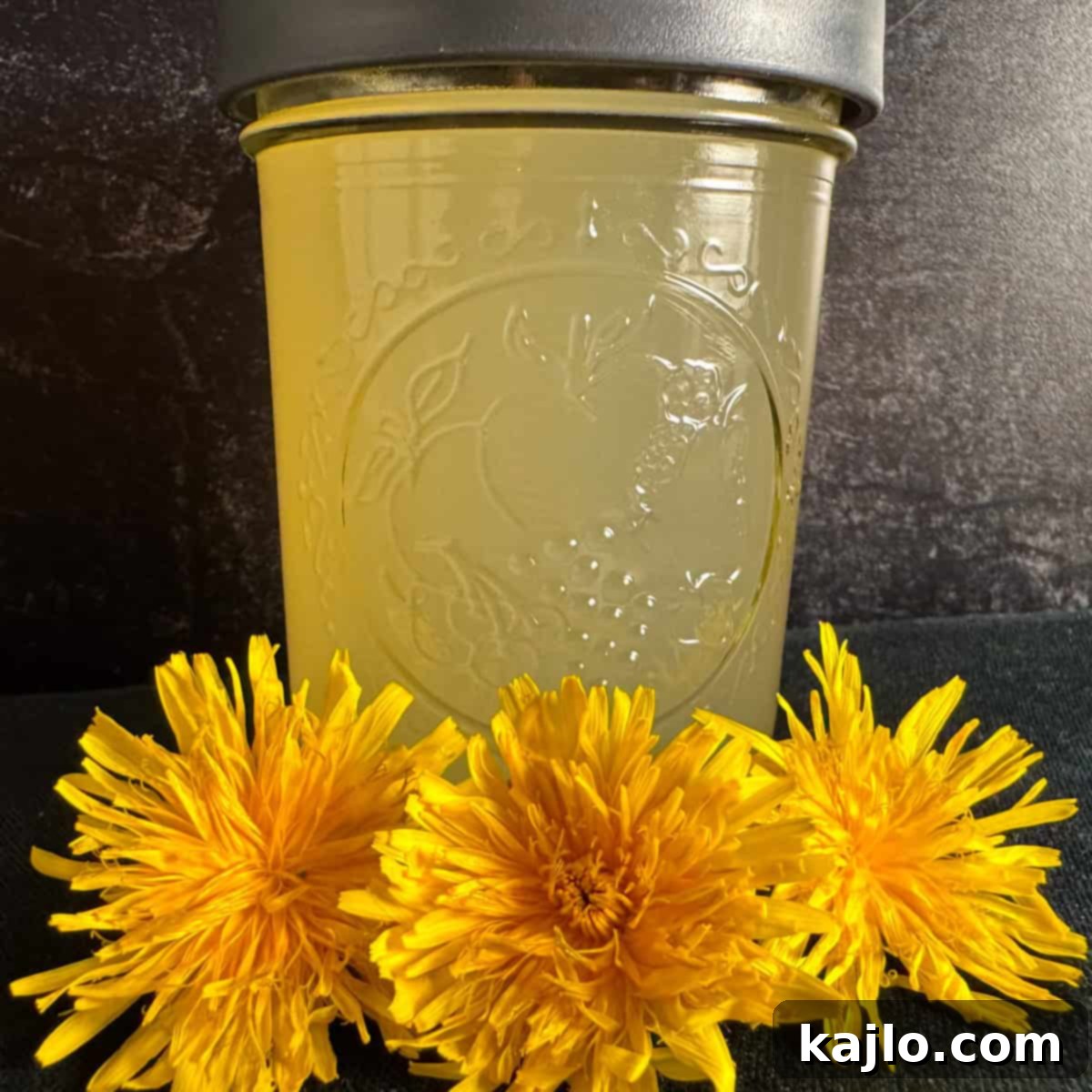
– Bettye
🌼 Craft Your Own Dandelion Vinegar: A Delicious Homemade Recipe
Dandelions are often overlooked, but their vibrant yellow blossoms offer a delicate, subtly sweet, and slightly floral flavor that makes them an excellent candidate for homemade vinegar. While dandelion leaves are known for their bitterness, the flowers contribute a milder profile, balancing the sharpness of the vinegar beautifully. Making dandelion vinegar from scratch ensures a pure, unadulterated taste that truly captures the essence of these cheerful wildflowers. This process transforms simple ingredients into a unique, light, and versatile vinegar perfect for various culinary applications.
Achieving the best results with dandelion vinegar often comes from crafting it entirely from scratch. This method allows the delicate floral notes to shine without being overshadowed. Fortunately, the process is straightforward, requiring only three common ingredients and a bit of patience. Here’s what you’ll need to begin your journey into homemade dandelion vinegar:
- Fresh dandelion blossoms (enough to loosely fill a pint jar)
- 2 tablespoons granulated sugar
- 2 cups water
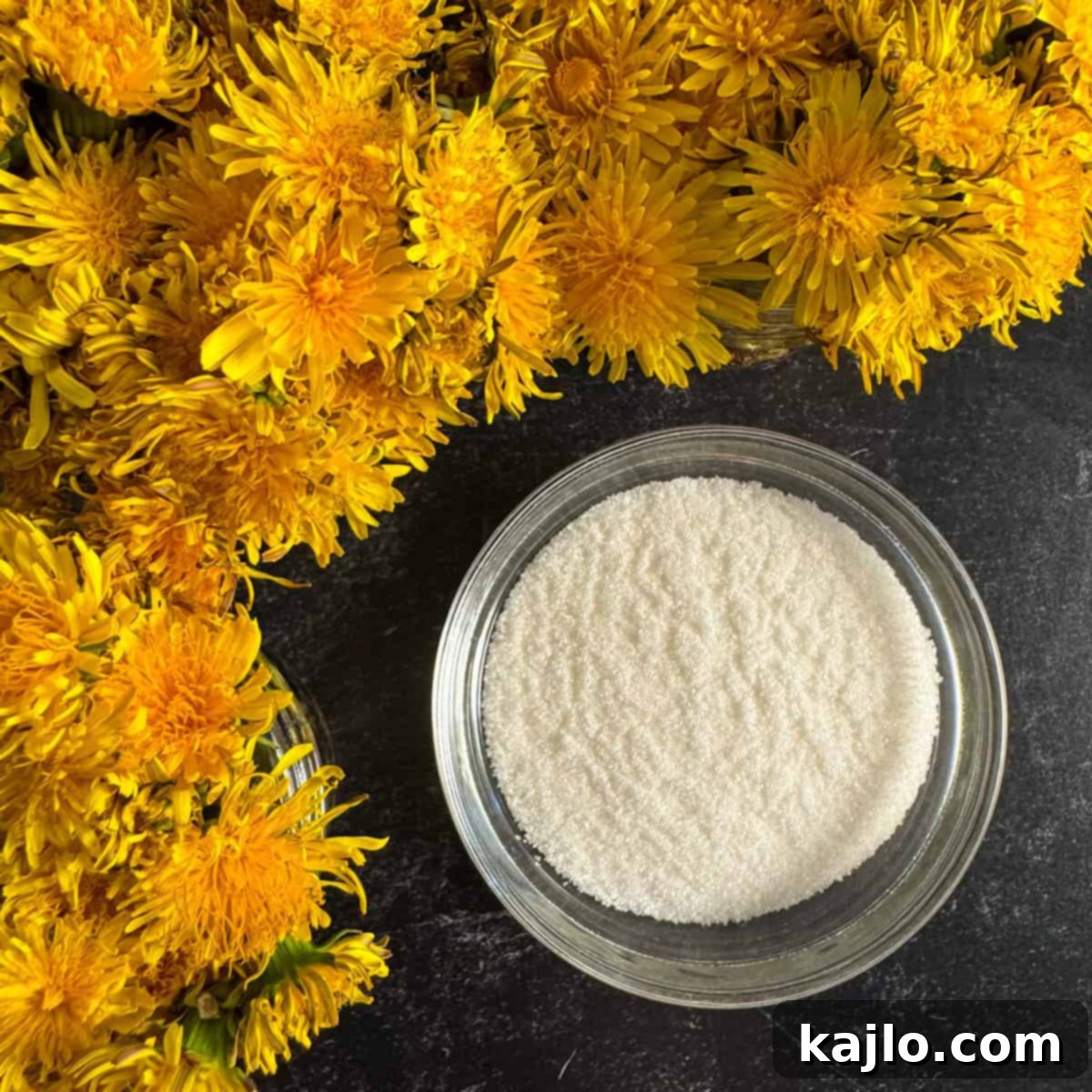
You’ll find a complete, printable recipe card at the end of this guide for your convenience!
Responsible Dandelion Foraging: Tips for a Safe Harvest
To ensure the best quality and safety for your dandelion vinegar, it’s crucial to select your blossoms carefully. For this recipe, aim to collect enough fresh dandelion petals to loosely fill a pint jar. When foraging, always prioritize areas that are free from chemical sprays and away from busy roads, which can expose the plants to exhaust fumes and other pollutants. Ideal spots include your own untreated backyard, undisturbed fields, or remote natural areas.
If you plan to pick dandelions on property that isn’t your own, it is always important and courteous to obtain permission from the landowner beforehand. While dandelions are common, you never know if the property owner has their own plans for these versatile plants, perhaps for crafting delicious dandelion wine, preparing delightful fried dandelions, or even making their own batch of this very dandelion flower vinegar. Respectful foraging ensures a sustainable harvest and good neighborly relations.
Crafting Homemade Dandelion Vinegar: A Step-by-Step Guide
Making dandelion vinegar from scratch is a rewarding process that taps into the ancient art of fermentation. This method ensures a vibrant, fresh flavor profile unique to homemade vinegars. Follow these steps carefully to create your own batch of this golden elixir.
Begin by dissolving the granulated sugar completely in the water. This sugar acts as the initial food source for the yeast during the first stage of fermentation, converting it into alcohol, which will later transform into acetic acid (vinegar). Ensure the sugar is fully integrated into the water to provide a consistent base for the fermentation process. You can gently warm the water to aid dissolution, but make sure it cools completely before adding the dandelions.
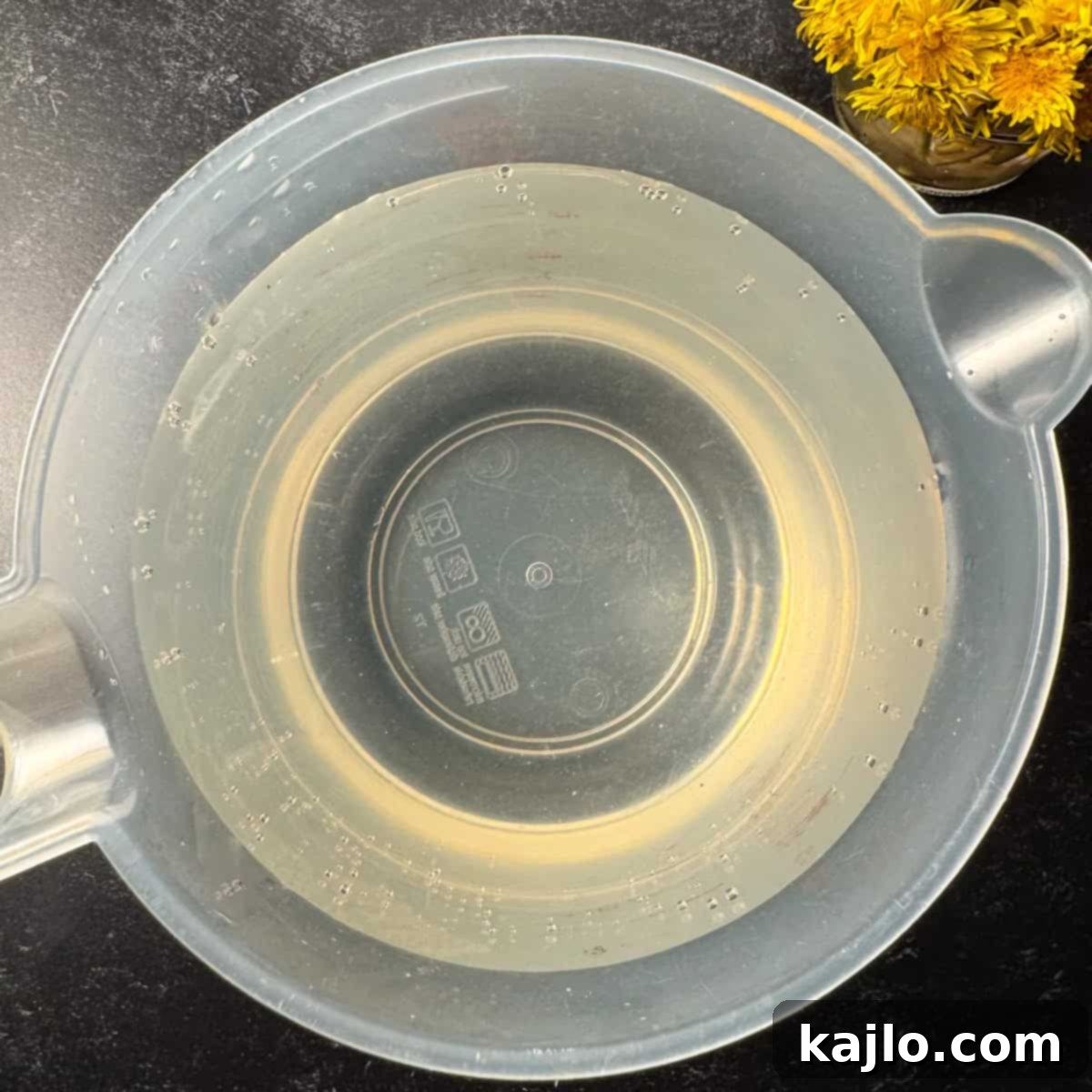
Carefully clean your freshly picked dandelions. Gently rinse them under cool water to remove any dirt, small insects, or pollen. The most critical step here is to separate the bright yellow petals from the green parts of the blossom, including the stems, leaves, and the green base (calyx). The green parts contain bitter compounds that can negatively impact the delicate flavor of your vinegar. Pack the pure yellow petals into a clean glass pint jar, ensuring they are loosely packed but leave sufficient space (about an inch) at the top of the jar for fermentation activity.
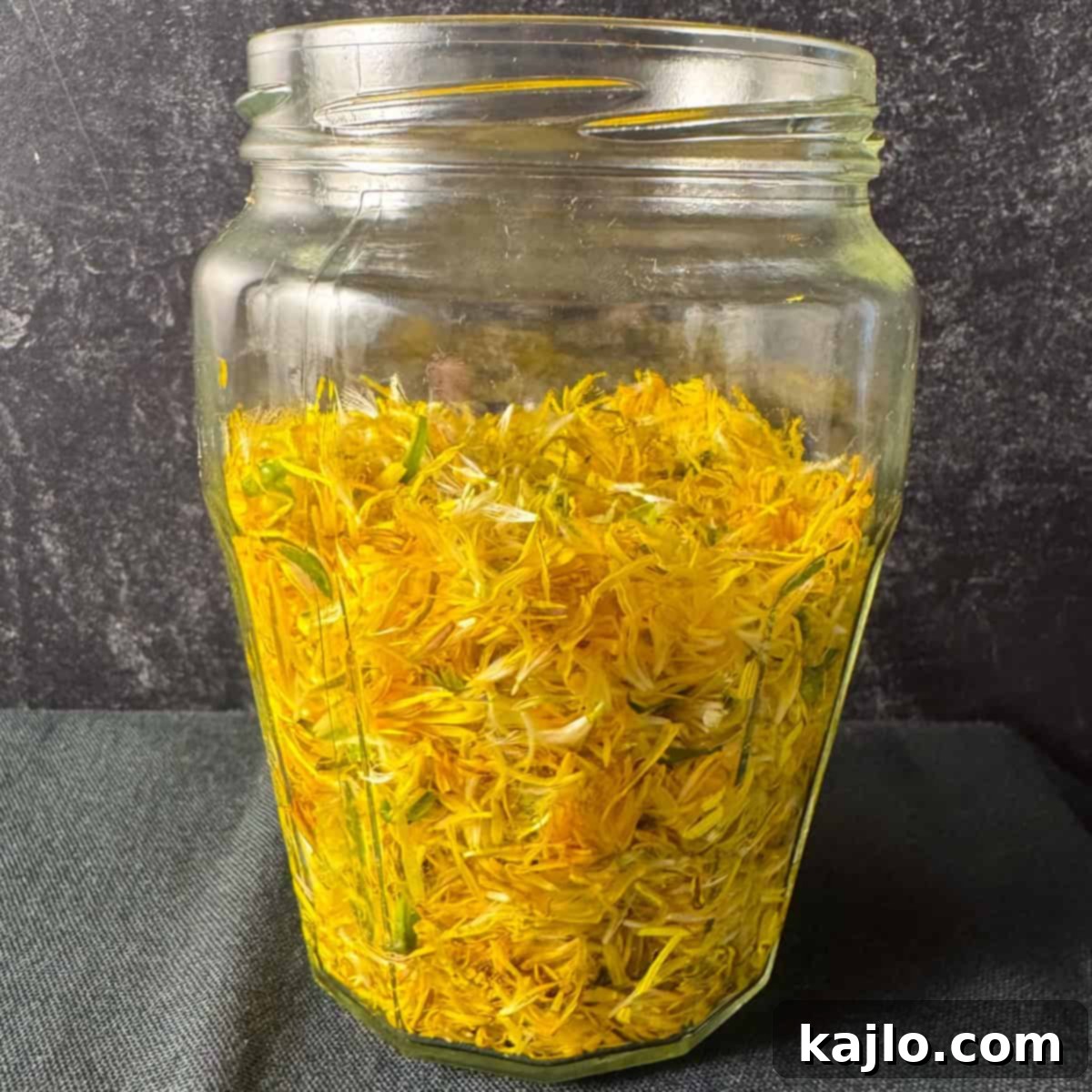
Pour the cooled sugar water over the packed dandelion petals in the jar, making sure to fully submerge them. It is crucial that all petals remain under the liquid surface to prevent mold growth; any petals exposed to air will spoil. Use a fermentation weight or a small, clean plate to keep the petals submerged. Cover the mouth of the jar with a piece of breathable cheesecloth secured with a rubber band. This setup allows air circulation for the acetic acid bacteria while protecting the mixture from flies, dust, and other contaminants. Leave the jar to ferment at a stable room temperature (ideally between 68-75°F or 20-24°C) for one week. During this initial phase, naturally occurring wild yeasts will begin converting the sugar into alcohol.
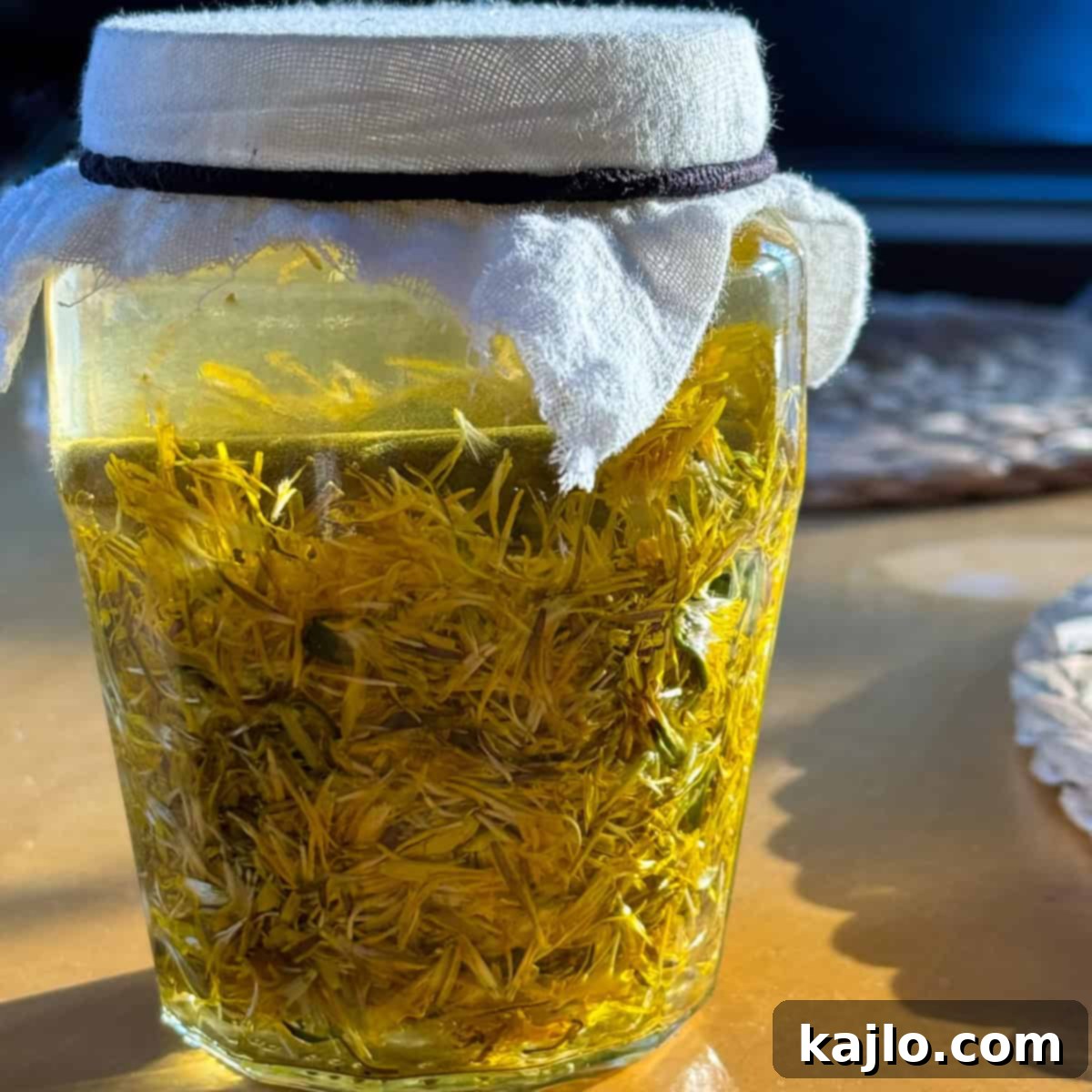
After one week of initial fermentation, it’s time to remove the spent dandelion petals. Strain the liquid through a fine-mesh sieve or cheesecloth into a clean jar, discarding the petals. This step separates the solids, allowing the liquid to continue its transformation into vinegar. Recover the jar with a fresh piece of cheesecloth and a rubber band. Allow the strained liquid to ferment for an additional 2-3 weeks at room temperature. During this secondary fermentation, acetic acid bacteria (often appearing as a jelly-like “mother of vinegar”) will convert the alcohol into acetic acid, creating your vinegar. Periodically agitate the jar gently to encourage air exposure for the bacteria, and skim off any foam that forms on the surface. This helps maintain a healthy fermentation environment.
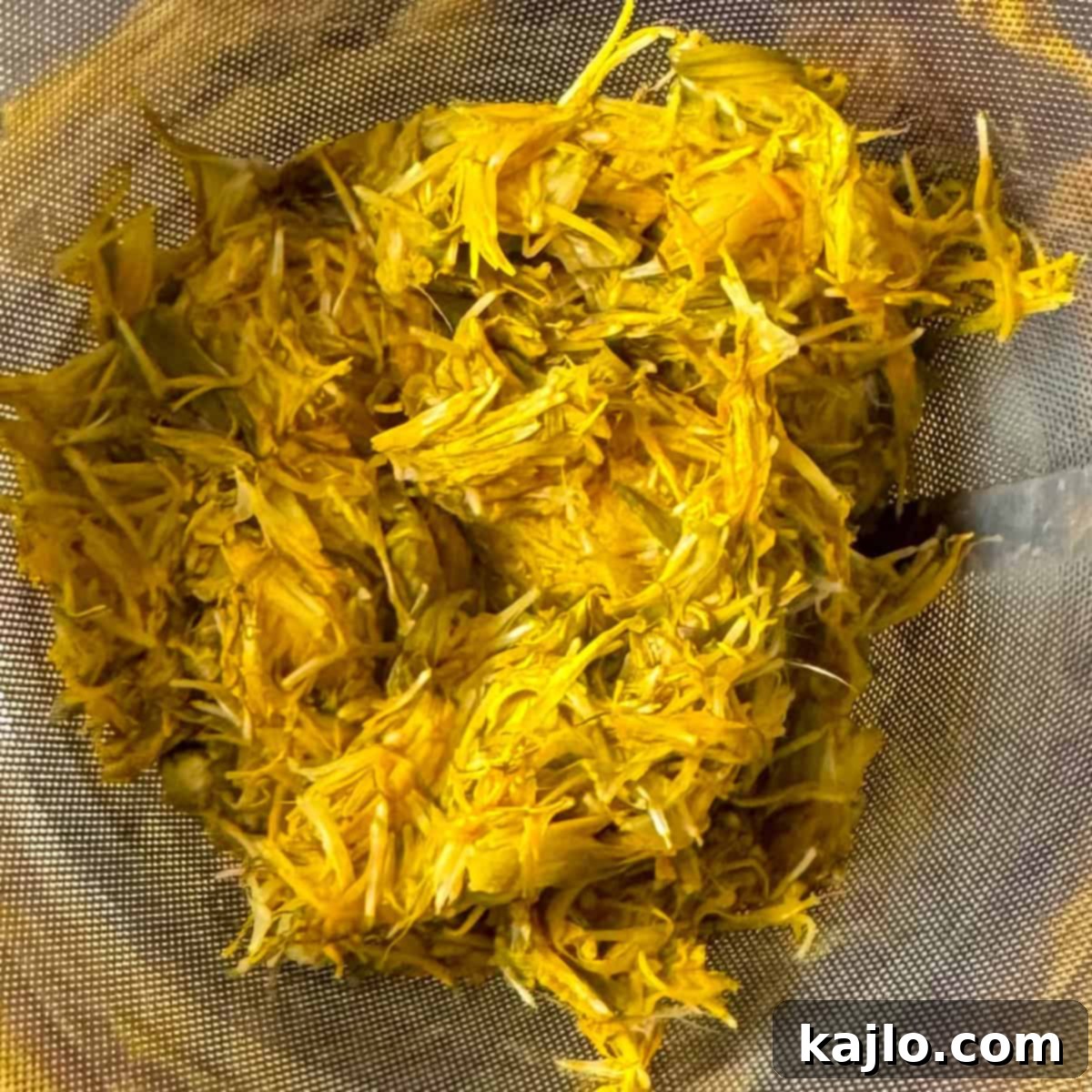
Your dandelion vinegar is ready when it smells distinctly like vinegar—tangy and acidic, rather than alcoholic. The longer it ferments, the stronger the acetic acid will become. Once it reaches your desired tartness, transfer the finished vinegar to the refrigerator for storage. To allow any residual gas to escape, cover the jar loosely with a plastic baggie secured with a rubber band, or use a bottle with a non-airtight stopper. Properly stored in the fridge, your homemade dandelion vinegar can last for several months, ready to enhance your favorite dishes.
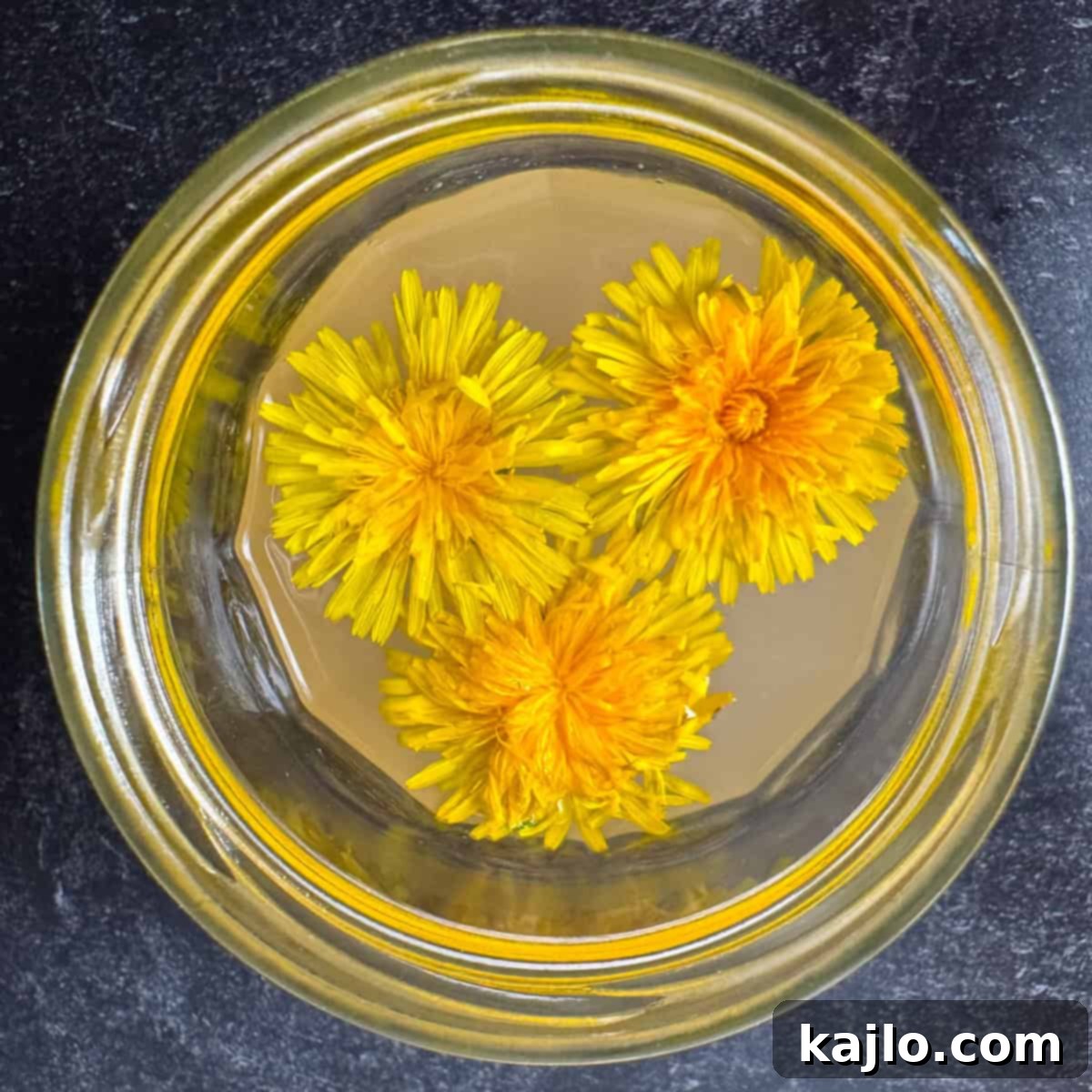
The beauty of dandelion blossoms lies in their gentle, subtly sweet flavor, which contrasts beautifully with the astringency often found in dandelion leaves. This inherent sweetness lends a delightful balance to the sharpness of homemade vinegar, resulting in a light and mild condiment. This unique floral-tart profile makes dandelion vinegar an exceptional ingredient for a variety of culinary uses. It shines particularly well in vibrant vinaigrettes and other salad dressings, adding a sophisticated touch to fresh greens. Beyond salads, consider incorporating it into hollandaise sauce for an herbaceous twist, using it in brines for poultry or vegetables, or adding a splash to braises to brighten and tenderize your dishes.
💡 Dandelion Infused Vinegar: A Quick and Simple Alternative
If you’re looking for an even simpler way to enjoy the subtle flavor of dandelions, making an infused vinegar is an excellent choice. This technique is incredibly easy, barely requiring a detailed recipe. The basic principle involves steeping your chosen herbs, spices, fruits, or in this case, dandelion petals, directly into an existing vinegar base.
For optimal results and to allow the delicate dandelion flavor to truly shine, I highly recommend starting with a mild and light-colored vinegar. Excellent choices include white wine vinegar, apple cider vinegar (ACV), or white balsamic vinegar. Avoid using regular distilled white vinegar, as its strong, sharp taste would likely overpower the nuanced floral notes of the dandelions.
To prepare infused dandelion vinegar, simply place clean, separated dandelion petals into a jar and cover them with your chosen mild vinegar in roughly a 1:1 ratio by volume. Ensure the petals are fully submerged using a small jar weight if necessary. Cover the jar with cheesecloth secured by a rubber band and let it sit at room temperature. The infusion process typically takes about two weeks, during which the vinegar will gradually take on a beautiful pale yellow hue and subtle dandelion essence. For a deeper flavor, you can extend the infusion period to three weeks or even longer. As with many slow food recipes, patience is rewarded with enhanced taste.
Watch How to Make It!
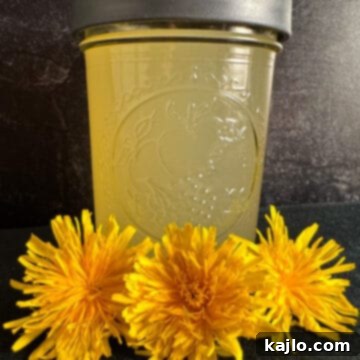
Dandelion Vinegar Recipe
Summer Yule
Print Recipe
Pin Recipe
15 minutes
25-35 days
Slow Food DIY
American
12
5
kcal
Ingredients
-
2
cups
fresh dandelion blossoms (petals only)
-
2
tablespoons
granulated sugar
-
2
cups
water
Love this recipe?
Please leave a comment below 😊
Instructions
- In a clean bowl or container, thoroughly stir the granulated sugar into the water until it is completely dissolved. This sugar water solution will serve as the initial fermenting liquid for your dandelions.
- Carefully rinse the dandelion blossoms under cool water to remove any dirt, small insects, or pollen. The next crucial step is to meticulously separate the bright yellow petals from all green parts of the blossom, including the stem, leaves, and the bitter green calyx. Pack these pure yellow petals into a clean glass pint jar, leaving about an inch of headspace at the top.
- Pour the prepared sugar water over the dandelion petals in the jar, ensuring all petals are completely submerged. It is vital to keep the petals under the liquid surface to prevent mold growth; use a fermentation weight or a small, clean plate to hold them down.
Cover the mouth of the jar with a piece of breathable cheesecloth, secured tightly with a rubber band. This allows air to circulate while keeping out unwanted pests and dust. Place the jar in a quiet spot at room temperature (ideally 68-75°F or 20-24°C) to ferment for one week.
- After the initial week, strain the liquid through a fine-mesh sieve or fresh cheesecloth into a clean jar, discarding the spent dandelion petals. Recover the new jar with cheesecloth and allow the liquid to ferment for an additional 2-3 weeks at room temperature. During this period, gently agitate the jar periodically (once every few days) to introduce air, which helps the acetic acid bacteria thrive. Skim off any foam or film that may form on the surface.
Once the vinegar smells distinctly acidic and has reached your desired level of tartness, it’s ready. Store the finished dandelion vinegar in a sealed container in the refrigerator to halt further fermentation and preserve its freshness.
Save this Recipe
Saved!
Equipment
-
Wide-Mouth Pint Jars -
Cheesecloth
Notes
💭 Expert Tips from Dietitian Summer Yule
This is a level 1 recipe, offering a low-calorie condiment that may support fat loss goals.
While dandelions have a long history in traditional medicine, it’s important to approach modern health claims with a critical eye. According to the National Center for Complementary and Integrative Health (NCCIH), “there’s no compelling scientific evidence supporting the use of dandelion for any specific health condition.” Therefore, widely circulated claims about dandelion vinegar’s efficacy for detox, belly fat reduction, or as a liver tonic should be taken with caution and a healthy dose of skepticism. Enjoy this vinegar for its unique flavor and culinary versatility, rather than as a medicinal cure.
A simple salad dressing often combines infused olive oils and vinegar. This homemade dandelion vinegar, like most vinegars, contains a negligible amount of calories. If you are on a weight management journey, a practical tip is to adjust the ratio in your salad dressings to include more vinegar and less added oil. This strategy allows you to enjoy flavorful and delicious dressings while keeping calorie density lower. Vinegar contributes tang and complexity without significant calories, making it a valuable tool for healthy eating.
The nutrition information provided is an estimate for one serving of dandelion vinegar.
Please note that these values can vary based on specific brands and ingredients used.
nutrition info disclaimer
All recipes on this website may or may not be appropriate for you, depending on your medical needs and personal preferences. Consult with a registered dietitian or your physician if you need help determining the dietary pattern that may be best for you.
The nutrition information is an estimate provided as a courtesy. It will differ depending on the specific brands and ingredients that you use. Calorie information on food labels may be inaccurate, so please don’t sweat the numbers too much.
“To taste” means to your preferences, which may have to be visual to follow food safety rules. Please don’t eat undercooked food x
Nutrition
Calories:
5
kcal
dandelion vinegar, dandelion vinegar recipe, homemade vinegar, infused vinegar, foraging dandelions
Shop our cookbook!
Easy Air Fryer Recipes for One
Burning your air fryer recipes?
Here’s how to fix it!
👨🍳 Creative Dandelion Flower Recipes: Beyond Vinegar
Dandelions are culinary powerhouses, offering much more than just vinegar. Their versatility means you can incorporate them into a wide array of dishes, from nourishing meals to refreshing drinks and even skincare. Don’t let these abundant garden treasures go to waste! Here are some more exciting ways to utilize fresh dandelion flowers in your kitchen and home:
- Dandelion Oil Recipe: This isn’t for eating, but for soothing skin! To create dandelion oil, simply fill a clean jar with fresh dandelion flowers and cover them completely with a carrier oil like olive, almond, or jojoba oil. Allow the mixture to infuse for a few weeks in a cool, dark place, then strain out the flowers. The resulting oil is wonderful for moisturizing dry skin, calming minor irritations, or in homemade salves.
- Dandelion Flower Tincture: For a unique addition to your homemade liquor cabinet, dandelion flower tincture is a delightful choice. Fill a jar with clean dandelion flowers and cover them with a neutral spirit like vodka. Let this mixture infuse for several weeks, then strain. The resulting floral-infused vodka can be enjoyed on its own, mixed into cocktails, or used in small amounts for its subtle flavor in culinary applications.
- Dandelion Tea: Both the leaves and roots of dandelions can be used to make a healthful tea. For a milder, slightly bitter tea, steep fresh or dried dandelion leaves in hot water for 5-10 minutes. If using roots, ensure they are thoroughly cleaned and roasted before steeping. Enhance the flavor with a touch of honey, a slice of lemon, or a sprig of mint.
- Dandelion Lemonade: Combine the refreshing tartness of lemonade with the subtle sweetness of dandelions. First, brew a batch of dandelion tea and allow it to cool completely. Then, mix the chilled dandelion tea with fresh lemon juice and your preferred sweetener (honey or maple syrup) to taste. Serve over ice for a unique and invigorating summer drink.
- Dandelion Jelly: Capture the essence of sunshine in a jar with dandelion jelly. This sweet spread often features a flavor reminiscent of light honey, making it a delightful topping for toast, scones, or as a unique accompaniment to a cheese board.
- Dandelion Chips: A healthy and surprisingly delicious snack, dandelion chips are a great way to use the leaves. Wash and dry fresh dandelion leaves thoroughly, then toss them lightly with olive oil and a pinch of salt. Bake them in the oven at a low temperature until they become wonderfully crispy. They make an excellent alternative to kale chips.
- Dandelion Burger Recipe: For a unique vegetarian option, consider making dandelion burgers. Sautéed or blanched dandelion greens can be mixed with mashed beans (like black beans or chickpeas), breadcrumbs, and your favorite herbs and spices. Form the mixture into patties and then grill or bake them until golden brown. This offers a nutritious and flavorful way to enjoy dandelions as a main course.
Join our community!
Subscribe
for all of the latest and greatest recipes, and follow me on
Facebook
,
Pinterest
,
Instagram
, and
YouTube
!
